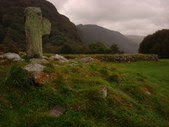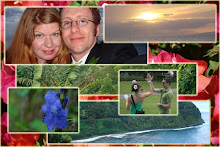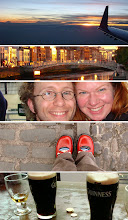When we came to Ireland, we had four nights of accommodation booked, and after that, we knew what we wanted to see, but we were not certain of our route or itinerary. It’s not my preferred way of travel, but in the off-season, you can do this. We knew we had two nights in Dublin, and Pete needed to be in Wexford to play a gig the third night. Then we would head further into the country to stay at a farmhouse near Ardfinnan. After that, there were no set plans. This was a compromise between Pete and I; between his ability to play-it-by-ear and my inability to relax unless I knew where I would be staying that night.
From the car rental office in Dublin, we were heading south to Glendalough, a monastic complex about 75 kilometers away. In order to get there, we had our Ordinance Survey book, our Michelin map, and luck.
There are five kinds of roads in Ireland. M roads, N roads, R roads, L roads, and all the other roads. M roads are motorways, N roads are National roads, R roads are Regional roads, and L roads are Local. Each of these roads has its corresponding speed limit, and in total, there are five different types of speed limits: town and city (50km), national road (100km), regional and local (80km), motorway (120km), and special (30km or 60km). I can tell you now that most sane people in America would not drive 80km (50mph) on a lot of those R and L roads, let alone the 100km (62mph) that is in place on those N roads. Often, the only noticeable difference between the R, L, and N roads is the absence or presence of a white line down the middle. When you are flying through the coutryside in a pillbox on wheels with a 10 foot high stone wall on your left and cars coming at you on your right down a 12 foot wide road, 50 miles an hour feels very fast.
We took the M50 around Dublin from north to south and got off on a likely looking R road. Being used to looking for exits based either on numbers or on the largest closest town, I thought I would be all right, as they seemed to be using both. But I missed the exit I was looking for, we took the second, and none of the towns on the signs were the ones I thought would be there.
We finally made it to the little town of Enniskerry, which I could find on the map, and in which I knew we simply had to find the appropriate R road, so we could be on our merry way.
Let me tell you now that the R roads are not always marked.
I found myself falling back on "I think we should be going that way" more than I would have wished, especially given the imminent peril in which I continuously felt myself to be. Finding ourselves in the parking lot of Glendalough was a fantastic relief. We were planning on getting our Heritage Card there, touring the site, and then getting something to eat in nearby Laragh.
The Heritage Card is a 20 Euro card akin to our National Parks Pass: an annual pass that gets you into all Heritage Sites in Ireland, which are managed by the Office of Public Works. It’s quite a deal if you are going to be visiting a lot of them; most sites are 2-5 Euros per person, and they can add up. To me, it seemed like a good idea, even if we did not make it to a value of 20 per person: it’s good to contribute to public parks and historical sites.
The woman at the counter in the visitor centre did not seem to agree. We said we wanted one, she said they were cash only, we did not have quite enough cash, so we needed to go into town to get some. She proceeded to try to discourage us from buying one, and then told us that if we did not want to use anything in the visitor center, we did not even have to pay there if we did not want to. But, we
want to pay. We
want a card. We decided to go in to town to get cash and some food and then come back.
The first restaurant was teeming with seniors and bus tours. It was cafeteria style and very noisy. We liked the interior of the place and its pubby atmosphere, but we wanted a menu, we wanted to sit, and we wanted to relax. The drive had been harrowing for me, and I didn’t want to navigate anymore. We walked down the street to a little restaurant called the "Wicklow Heather" that was much quieter and more expensive. It was a nice lunch of stew, seafood chowder, coffee, and tea to go with the rather rainy day that had developed over our drive down.
Rain at Glendalough seemed appropriate. Though it was not as awe inspiring as I was lead to believe from the photographs, the grey misty raininess gave it more of a feeling of age and isolation appropriate to its history. Even relatively people-free, there were too many people, it was too close to the road, and not remote enough. It’s like pictures of Yosemite: it seems far away from everything, but what is happening behind the picture is a bustling hive of humanity. This place must be a zoo in the summer. All the same, it is amazing what humans have built.

Glendalough is a monastic complex founded by St. Kevin (St. Caoimhghin) in the 6th century. It sits in a dramatic valley in the Wicklow mountains, and is named as such: glen of the two lakes. There is a 30 meter tall round tower and numerous stone churches and crosses. This was the first of our many visits to places of Irish antiquity, and it was one that I did not want to miss. I figured we would need a couple of hours to poke around, and we could well have done with more: the mountains host many hiking and walking trails, but time was not on our side for such things, and neither was the weather.
The place is crawling with photo opportunities. I crouched in a roofless stone structure, looking through a window that perfectly framed the oldest stone cross in the complex, looking for a shot... when a group of German tourists came along and took turns... hugging it. Yes, hugging an old, wet, grey, rock.
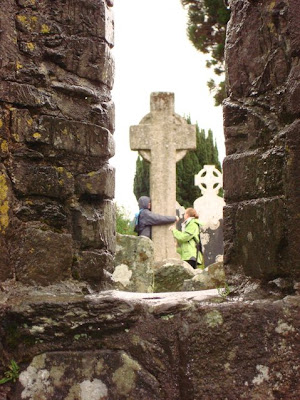
But I can file this little ritual with other things I don't understand, like throwing coins into fountains or, at Glendalough, into the stream that borders the monastic complex. Is it wishes? Wouldn't it be more productive to save up those most likely selfish dreams and perhaps donate a sum at the end of the year to a charity? Maybe if you hug a cross and toss a 20p piece in the water, you will live forever and escape the vengeance of an irrational god, and I am totally missing out.
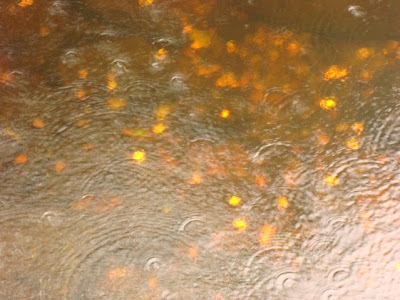
It's not only a country's history, scenery, and people that are fascinating and worth observing and noting; the little things can be equally engrossing. Signs, for example. The way in which different cultures choose to denote things of importance can be odd sometimes to the outsider. Highway signs and the like are usually quite similar, but more specific signs for the public good can be quite funny to me. The one on the edge of the upper lake at Glendalough was excellent.
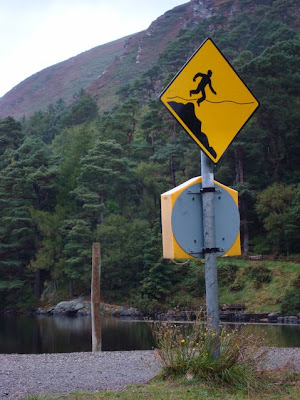
I am not sure exactly what is going on here. Am I not supposed to throw myself into the lake? Will the rocky shore of the lake suddenly drop out from under me? If I get too close to the end of the lake, will it suck me in. In any case, I decided to keep my distance, and we left Glendalough in one piece.
